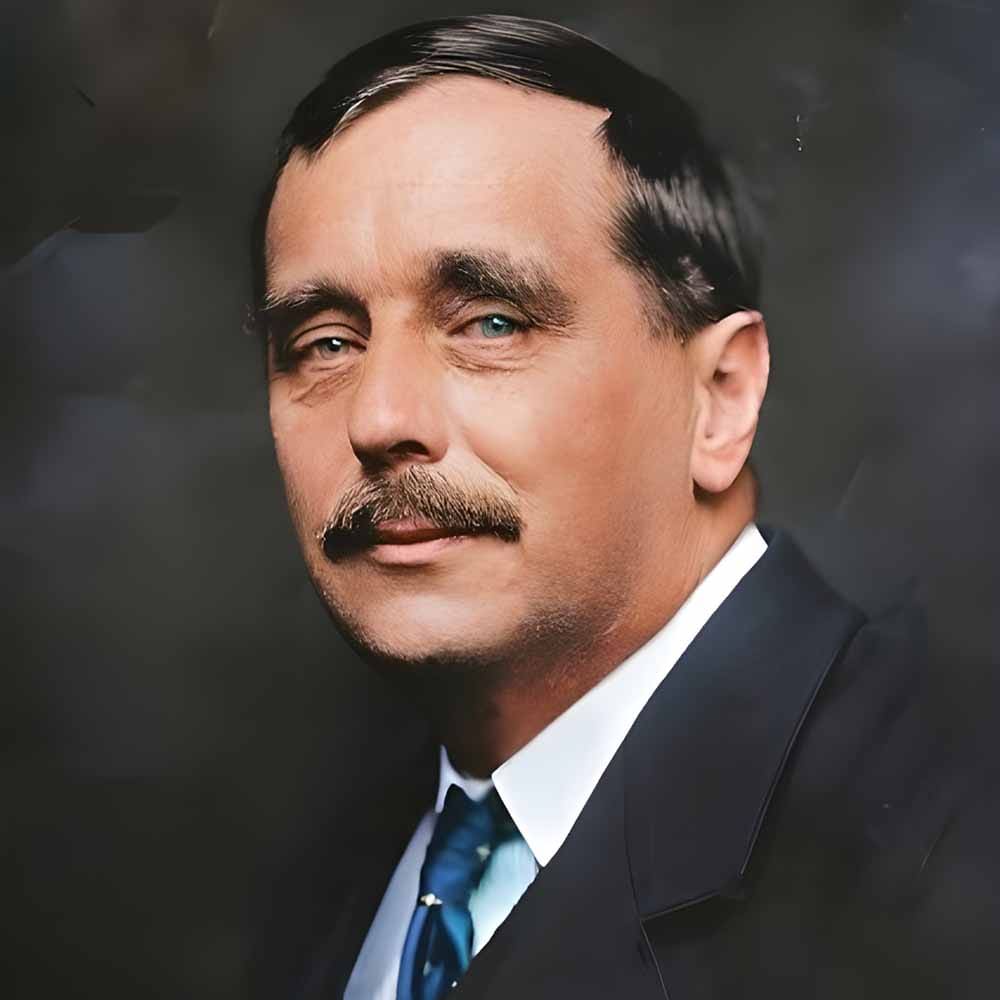
H.G. Wells: Pioneer of Science Fiction and Futuristic Vision
H.G. Wells, born Herbert George Wells, was an English writer predominantly known for his works in the science fiction genre. His notable contributions to literature include pioneering novels such as The War of the Worlds, The Time Machine, and The Invisible Man, which have earned him the title of “the father of science fiction.” His writing was characterized by a prophetic vision, imagining inventions and scenarios that would only become feasible much later in the technological evolution of the 20th and 21st centuries.
Wells’ literature was not limited to entertainment but often wove in social commentary and speculative foresight. His stories frequently explored themes of futurism, societal structure, and the human condition. This intersection of imaginative narrative and critical observation marked Wells as a significant figure in both popular fiction and the deeper exploration of modernity’s potential consequences.
Through a combination of vivid storytelling and intellectual rigor, Wells established a literary legacy that has influenced countless authors and thinkers within and beyond the bounds of science fiction. His ability to construct compelling narratives that ask profound questions about progress, morality, and the nature of humanity continues to resonate with readers and remains a cornerstone of the genre.
1. Early Life and Education
Herbert George Wells was born into a lower-middle-class family, experiencing a modest upbringing that greatly influenced his future works. His education laid the groundwork for his scientific literacy, which became a hallmark of his writing career.
Childhood in Bromley
Born on September 21, 1866, in Bromley, Kent, H.G. Wells was the son of Joseph Wells, a shopkeeper and professional cricketer, and his wife Sarah Neal, a domestic servant. His family struggled financially, and the economic hardships they experienced during his childhood instilled in him a certain awareness of class disparities. Despite the monetary constraints, Wells found solace in reading, which ignited his interest in science and literature.
Studies at Normal School of Science
Wells’ academic journey took a pivotal turn when he secured a scholarship to attend the Normal School of Science (now part of Imperial College London) in South Kensington, London. Studying biology under Thomas Henry Huxley, Wells was captivated by the Darwinian theories of evolution. His time at the institution, which later was incorporated into London University, played a significant role in shaping his scientific knowledge, enabling him to integrate these concepts into his later imaginative works.
2. Literary Career
H.G. Wells’ literary career encapsulates his early forays into literature, meteoric rise to fame with pioneering science fiction novels, and his persistent exploration of various themes until his later years.
Early Writings
Wells began his career as a writer with a focus on short stories and articles. He worked briefly as a teacher and a pharmacist’s assistant, experiences that contributed to his early works. His initial literary efforts were published in various journals, where he honed his craft.
Rise to Fame
His breakthrough came with the publication of The Time Machine in 1895, a novel that laid the foundation for his reputation as a father of science fiction. The War of the Worlds and The Invisible Man followed, solidifying his status as an influential author and shaping the genre of science fiction. These novels captivated readers with their imaginative concepts and critical view of society.
Science Fiction Novels
| Novel | Publication Year | Notable Concepts |
|---|---|---|
| The Time Machine | 1895 | Time travel, social critique |
| The Island of Doctor Moreau | 1896 | Ethical boundaries, genetic engineering |
| The Invisible Man | 1897 | Invisibility, isolation |
| The War of the Worlds | 1898 | Alien invasion, human vulnerability |
His science fiction novels often explored themes of advancement and its potential consequences, a reflection of the contemporary fascination with progress and the future.
Later Works
In his later years, Wells expanded his writing beyond fiction. The Outline of History (1920) showcased his talent as a journalist and author, offering a panoramic account of world history. Additionally, he continued to publish novels such as Tono-Bungay (1909), which critiqued Edwardian society. With works like Experiment in Autobiography (1934) and The Shape of Things to Come (1933), he reflected on his life and speculated about the future of humanity.
3. Themes and Influence
H.G. Wells’ writings consistently address burgeoning social, political, and scientific concerns of his time. His work is marked by insightful predictions and a persistent exploration of evolving societal constructs.
Social and Political Commentary
Wells’ narratives often extend beyond mere storytelling to act as platforms for his socialist views and political ideologies, specifically those related to the Fabian Society, an organization advocating for gradual social change.
- Evolution of society: Wells infused his tales with social commentary on the implications of progress and evolution, envisioning future societies that had adapted—or failed to adapt—to scientific advancements.
- Satirical elements: His satire served as a critique of Edwardian social mores, exemplified by novels like The Invisible Man, which not only explore invisibility but also the invisibility of the marginalized in society.
Utopian works: Wells often contrasted current social ills with idealized futures, where humanity has overcome its challenges, which can be seen in his writings on utopian societies.
Scientific Romances
Renowned for his “scientific romances,” a term Wells preferred over science fiction novels, he pioneered the speculative fiction genre with his imaginative and scientifically informed speculations.
- Predictions: Wells’ stories are notable for accurate predictions of technological advancements such as lasers (The War of the Worlds) and atomic bombs (The World Set Free).
- Influence on science: His literature has not only shaped the science fiction novel form but has also purportedly influenced scientific thought, with science enthusiasts citing his works as inspiration.
Futuristic visions: Wells’ work provides a nuanced exploration of the potential consequences of scientific and technological progress, effectively merging storylines with philosophical debates about the future.
4. H.G. Wells Personal Life
H.G. Wells’ personal life was marked by complex relationships and health issues that influenced his later years. He was born in Bromley, Kent, and his experiences there shaped his outlook and literary works.
Relationships and Family
Wells had several significant relationships throughout his life, which often influenced his writing. He was married to his cousin, Isabel Mary Wells, but left her after three years to marry Amy Catherine Robbins, with whom he had two sons, George Philip and Frank Richard.
Wells also engaged in affairs with several women. Notably, he had a turbulent liaison with the writer Rebecca West, with whom he had a son, Anthony West. He was involved with Amber Reeves, with whom he had a daughter, Anna-Jane. These relationships, while controversial, were a testament to his disregard for societal norms regarding sex and marriage during his time.
| Relationship | Individual | Children |
|---|---|---|
| First marriage | Isabel Mary Wells | None |
| Second marriage | Amy Catherine Robbins | George Philip, Frank Richard |
| Affair | Rebecca West | Anthony West |
| Affair | Amber Reeves | Anna-Jane |
Health and Later Years
Wells struggled with his health over his lifetime. He suffered from poor health, which occasionally interrupted his work. Despite these challenges, he kept writing and engaging in social and political commentary. Wells’ declining health in his later years never deterred him from remaining active in literary and social circles. He passed away in 1946 from unspecified causes.
- Health Issues: Recurrent bouts of poor health, specific details not widely documented
- Later Activities: Continued writing and public engagement despite health challenges
- Death: 1946, after several years of declining health
5. Legacy and Impact
H.G. Wells’ indelible mark on literature and the cultural landscape extends far beyond his death, with his works continuing to inspire and influence.
Pop Culture and Adaptations
Film: Wells’ science fiction novels have been adapted into numerous films, which have brought his imaginative worlds to a broader audience. For instance, The War of the Worlds saw a groundbreaking adaptation by Orson Welles, who broadcast a radio adaptation in 1938 that famously caused public panic. This novel was later adapted into several films, the most notable being the 1953 and 2005 adaptations, which demonstrated the timelessness of Wells’ vision.
Literature: His influence on fellow writers was profound, with George Orwell citing Wells as a major influence. Wells is often referred to as the “Father of Science Fiction,” a title he shares with contemporaries like Jules Verne and Mary Shelley.
Human Rights: Beyond the realm of fiction, Wells used his platform to advocate for human rights. He was actively involved with the League of Nations and wrote extensively on social injustice and human rights issues, laying the groundwork for what would become the Universal Declaration of Human Rights.
Contributions to Science Fiction
Innovation: Wells’ contributions to the genre of science fiction are unparalleled. He utilized the genre as a medium for commentary on contemporary society and speculated on the future, which was not customary at that time.
Inspiration: Wells’ visions of alien invasions, time travel, and dystopian societies have not only shaped the framework of science fiction but have also sparked the imagination of readers and creatives alike. His speculative and often cautionary tales contain powerful insights into human behavior and the potential consequences of technological advancements.




